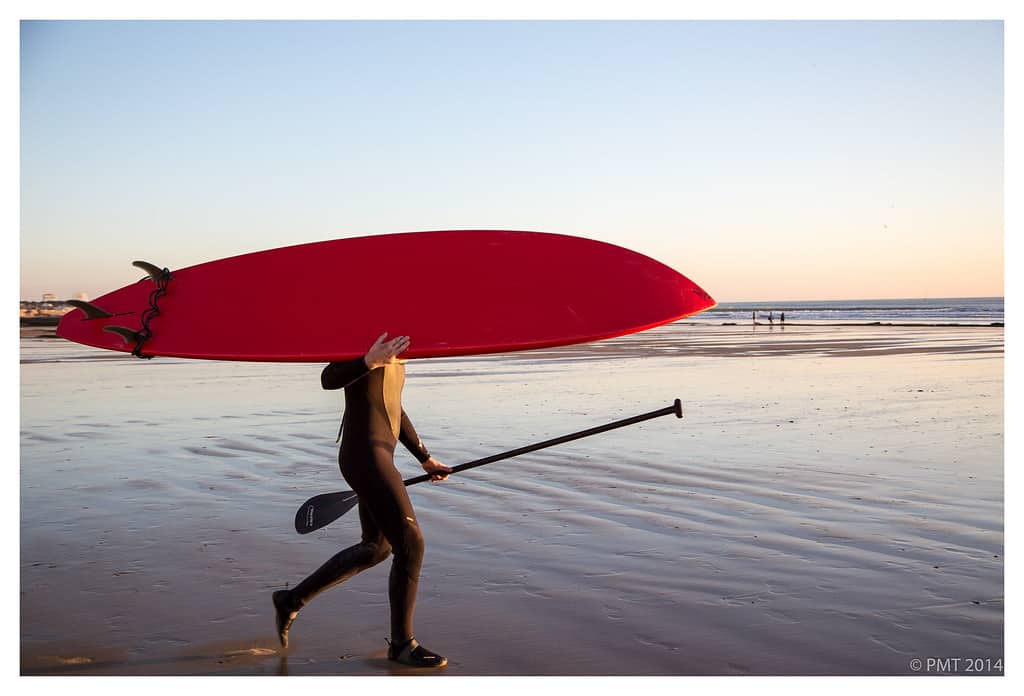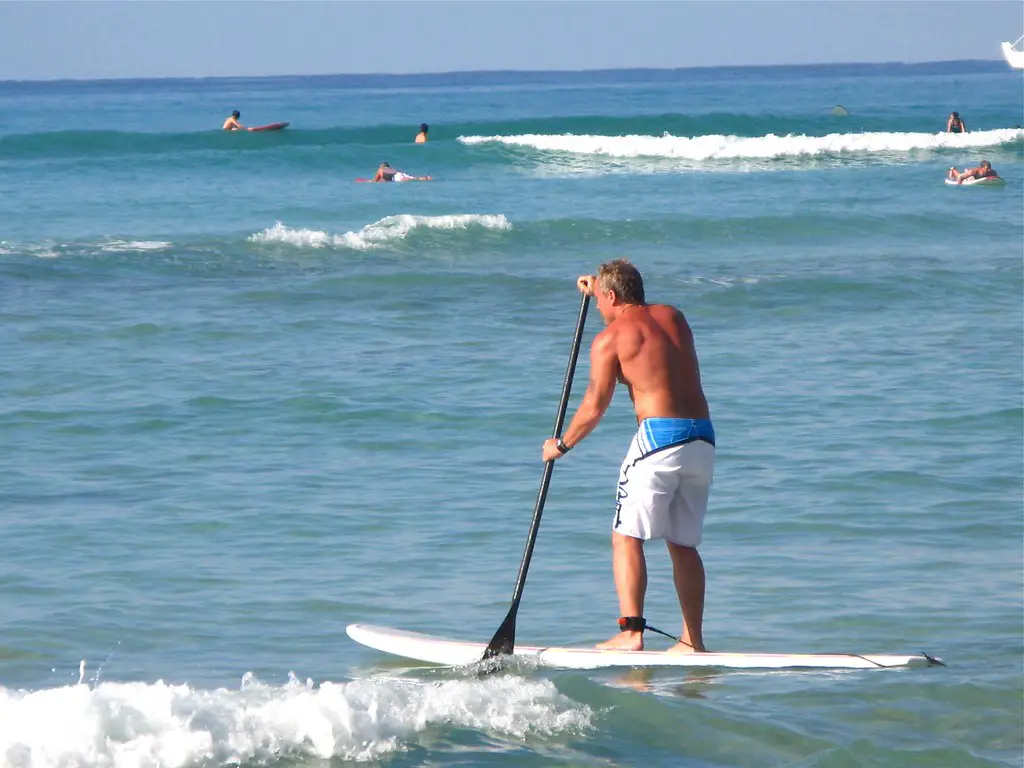Stand Up Paddle Board Tips – the second part of our “How to Stand Up Paddle Board”.
Learn the most important things you need to know about SUP Paddle Board Technique.
In this 2nd episode, we’ll show you How to get up on a Stand Up Paddle Board – and how to learn it the easy way!
In this article, we show you everything important about starting SUP:
- The three types of Stand Up Paddle Launch
- How to master getting up onto the SUP board properly
- How to learn the SUP start easily
- Tips and tricks to help you get up on the SUP board in different situations
So take 5 minutes, and then you will know the most important things so that you can learn how to launch SUP quickly and efficiently in the water.

If you are looking for other information and tips on Stand Up Paddle Boarding, take a look at our full Paddle Board Technique rubric. There is a good chance that you will find a good guide to your question.
In our stand up paddle instructions, we assume that you own or rent the required material. If not, check out our overview of boards and the Buying Guide!
As always, the “Safety Disclaimer” applies: stand up paddling is a water sport! You should, therefore, always adhere to the most critical safety rules. If you do not know them yet, check them out quickly here.
Tips for SUP launch – Everything you need to know to get up to speed quickly.
The three main types of Stand Up Paddle launches – the different ways of how to get up on a Stand Up Paddle Board
When getting up onto the SUP, we distinguish between three “types”:
- The beginner launch in shallow water
- The beginner launch in deep water
- The launch for advanced users
Stand Up Paddle Board Tip for Beginners:
Always make your first attempts at SUP in calm weather and water. That is, first, in an area with no or only small waves, especially without any substantial wind. In the following article, we have also selected videos that show the respective types of launches effectively. Taken together with our explanation, it should all become clear to you.
The Beginner SUP launch in shallow water
First phase – launch in shallow water:
The paddle lies across the board. Hold it loosely with both hands and stand sideways next to the board.
Make sure the paddle blade is horizontal so it doesn’t get stuck in the water. It is also essential that you are in knee-deep water so that you do not damage your fin when ascending and it does not get stuck in the ground.
Second phase – launch in shallow water:
Now, you can easily place your knee, which is closer to the board, behind the sweet spot on the board. To keep the board a bit more stable during your final ascent, you can push off with the other leg quickly in the direction you want to travel. Now, pull up your other leg, kneel, and take a stable position at the sweet spot.
Third phase – launch in shallow water:
From this kneeling position, you can now put one foot next to the knee of the other leg. You can also support yourself with the transverse paddle and ensure the correct balance. And now, just put your other foot on the sweet spot and stand up (still remember the slightly bent basic position). And already you are neatly in the parallel stand, and you can begin your first paddle moves!
How to make it even easier:
Since the board is more stable in the water when it rides more smoothly, you can also do the following:
From the kneeling position, straighten your upper body only and start paddling a bit. The arm position on the paddle is the same as when you paddle standing, except you do not grab the top of the shaft but rather move farther down. But make sure that the paddle is immersed in the water cleanly up to the transition between the paddle blade and the paddle shaft. Once you have picked up speed slightly, then start getting up as described above.
Bonus SUP Tip:
As a beginner, we recommend practising paddling on your knees. This position is helpful if you get tired from standing or if you get into more turbulent waters.
Here is a video showing the Beginner SUP Launch and how to find the sweet spot when you’re already on the water.
The Beginner SUP Launch in deep waters
Of course, you may fall down while paddling. Don’t worry; you won’t have to swim back to the beach again, even if it’s your first time on the board.
Getting up again on a Stand Up Paddle Board on in deep water is anything but difficult.
Stand Up Paddle Board Safety Tip:
- If you fall, try not to dive headfirst into the water, as you don’t know what’s beneath the surface.
- Wear an SUP leash to keep the board safe with you. If you don’t have a leash, always get the board first after you fall, then the paddle.
It’s much easier to get back to the beach if you lose your paddle than if you can’t get to your board anymore! You can paddle an SUP board very well with your hands while lying down, just like wave surfers do.
First phase – launch in deep water
As in the beach launch, your paddle should be perpendicular to the board, and the paddle blade should be aligned horizontally. If there are some waves, you should hold the paddle with one hand.
Second phase – launch in deep water:
Now, you can pull yourself with your other hand near the sweet spot from a prone position with your chest on the surface. If you are lying on the SUP board with your chest and upper abdominal region down, you can turn onto the top of the board. Now, hold the paddle with both hands and place yourself into the kneeling starting position.
Third phase – launch in deep water:
From the kneeling position, getting up works precisely the same as the third phase when starting from shallow water.
The second option for the launch in deep water:
A second option is to climb up from the tail of the board.
You grab the rear portion of the board sideways with both hands, press the stern slightly into the water, and pull your chest down onto the board.
After that, you have to slide forward a bit in the prone position so that your chest and the upper abdominal area are about at the sweet spot. From here, you go back to the kneeling starting position and then up.
We have selected a very good video for you showing both options for getting back on the board in deep water and riding off:
- Option 1: Lateral ascent from minute 1:15
- Option 2: Ascent over the rear from minute 1:22
The SUP launch in shallow waters for advanced users
If you feel confident enough on the stand-up paddle board, you can accelerate the process, of course.
First phase – launch for advanced users in shallow water:
Go to the same starting position as the beginner launch: the board is next to you, and the paddle lies across the board with the paddle blade horizontal.
Second phase – launch for advanced users in shallow water:
However, instead of putting your knee on the board near the sweet spot, you put your foot directly on the board. Now you pull your second leg out of the water and get up onto the board in a smooth movement. And that’s it!
How you will do the SUP Launch after some practice
Once you have practised this a few times, you will notice that it is even faster:
In the end, you will no longer put one foot after the other on the board but jump directly from the starting position, swinging up onto the board and into the parallel stance.
Bonus SUP Tip:
In particular, if you will be traveling with the SUP in uneven coastal wages, you should practice paddling on your knees, fast and speedy ascents, and paddling in advance.
Bonus Stand Up Paddle Board Tip: The beach launch – or how to get going without getting wet
The beach launch is especially useful in cooler weather or with a more challenging water entry, e.g., if there are stones or the like.
You lead your board “backwards,” i.e., with the fin in front going into the water.
Essentially, this means you are still standing on the beach and holding your board at the bow. It is essential for you to put the board in the water so that the fin is in about knee-deep water during your ascent.
Now you can simply climb over the bow onto your knees towards the sweet spot and get up there as with the other types of launches. Try to push yourself off the shore before putting your other knee on the board.
Key takeaways for the ‘How to get up on a Stand Up Paddle Board’
The SUP launch and getting up on the stand up paddle board are not such complicated things.
For an absolute beginner, it is important at the outset that you get a feel for where the sweet spot of the SUP board is. If you are not sure or do not yet have that, you can orient yourself by the grip recess on most boards. This is always close to the sweet spot.
For training in the water, take the following key takeaways with you:
SUP Launch in shallow water
Stand sideways to the board and hold the paddle crossways with both hands. Align the paddle blade horizontally.
Now place your knee close to the sweet spot on the board, push up with your other leg, and then put that knee on the sweet spot as well.
From the kneeling position, move your feet to the sweet spot one after the other, supporting yourself with both hands on the paddle.
SUP Launch in deep water
Swim across the board and hold the paddle across the board with one hand.
Pul yourself onto the board in a prone position so your chest/upper abdominal area is on the sweet spot. Turn on the board.
Lift your upper body by supporting yourself with both hands on the paddle.
Now, pull your knees to the sweet spot. From the kneeling position, you can now get up the same way as when climbing out of shallow water.
Important SUP Tip for Beginners
As a beginner, you should also practice paddling in the kneeling position. On the one hand, this will help you get up, as the board is more stable and provides a smoother ride in the water. Additionally, this will also be helpful if you are travelling in somewhat rougher water.
How to stand up paddle board: Where you can find more about paddle board technique
We hope that this overview of the basics of SUP technology will help you with your first excursions on the water.
And remember: Practice is key and even fun with SUP!
So off to the water and get wet! If you still want to know more about How to Paddle Board and SUP paddle techniques, take a deeper look at the other tips in our SUP guide.







